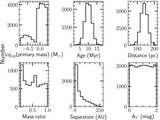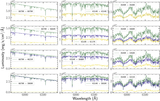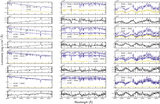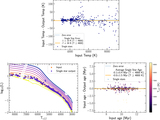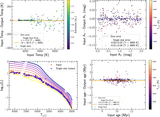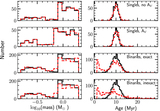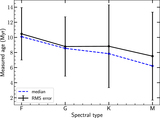Image Details

Caption: Figure 7.
Fit summary plots for a 1200-system subsample of the exact-distance population of single and binary stars with extinction. Top left: Input primary-star (crosses) or single-star (points) temperature vs. Teff residual (input–output temperature). The average temperature error is 0 K with an rms of 4 K for Teff < 4800 K and −8 K with an rms of 60 K for Teff ≥ 4800 K. The first color bar shows the AV for each single star, while the second color bar indicates the temperature difference between the primary and secondary stars in each binary. Binary stars systematically have a positive temperature residual: the presence of an unknown secondary star biases temperature measurement. Top right: Input extinction vs. extinction residuals for binaries (crosses) and single stars (points). Multiplicity does not affect the quality of the AV retrieval: we find an average error of 0.00 mag with an rms of 0.03 mag for all temperatures, which is the same as the single-star result. Bottom left: HR diagram of input primary and single stars (purple points) and output single stars (orange points) and unresolved binaries (crosses). The color bar shows the temperature difference between the two binary components. Binaries with a small temperature difference are the most offset from the input, because the flux ratio is high enough for the secondary spectrum to impact the composite spectrum. Low-mass binaries appear younger than high-mass binaries. Bottom right: Input age vs. age residuals for both binaries (crosses) and single stars (points). Multiple stars are systematically measured to be younger than single stars, with an upper envelope appearing because age cannot be negative. Binaries have an average age residual of 4.35 Myr with an rms of 3.78 Myr, while single stars have an average residual of −0.12 Myr with an rms of 0.25 Myr for Teff < 4800 K and of −0.38 Myr with an rms of 2.13 Myr for Teff ≥ 4800 K, which is the same as the single-star-only case.
Copyright and Terms & Conditions
© 2021. The American Astronomical Society. All rights reserved.



